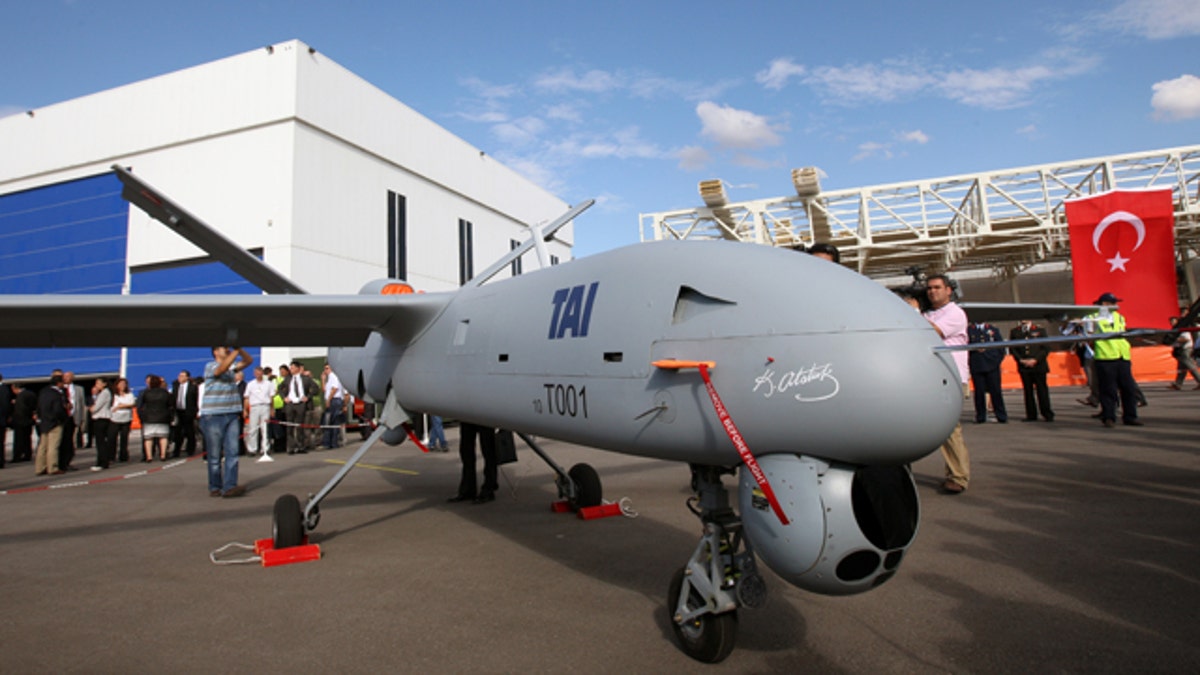
Turkey's first drone airplane called Anka or Phoenix is seen during a roll out ceremony at the TAI - Turkish Aerospace Space Industries Inc., near Ankara, Turkey, Friday, July 16, 2010. Anka, is a surveillance craft able to fly for 24-hour stretches over the rugged mountains where Kurdish rebels are waging a deadly insurgency. (AP Photo/Burhan Ozbilici)
ANKARA, Turkey -- Turkey on Friday unveiled its first drone airplane, a surveillance craft able to fly for 24-hour stretches over the rugged mountains where Kurdish rebels are waging a deadly insurgency.
Turkey's eagerness to produce it own military technology mirrors its increasingly robust and independent diplomacy in the region. Producing its own drone fleet would allow Turkey to sever an important link with Israel, which has provided Turkey with drones even amid rising tensions over the Gaza Strip. While the success of the Turkish-made drone is far from assured, Turkish engineers said they were confident it would become part of the country's arsenal.
Ozcan Ertem, head of the project, said an armed version of the Anka, or Phoenix, was possible but not in the works for now.
Some 43 countries have now developed unmanned aerial vehicles, which have proved to be extremely effective in gathering intelligence and, in U.S. hands, staging attacks in Afghanistan, Pakistan and Iraq.
Ertem said four or five countries, including Pakistan, which has also sought drones from the U.S., are expected to place orders for the Anka once the Turkish Air Force issues an order probably later this year. The first system, comprising three planes and remote-control units, was expected to be delivered to the Turkish Air Force in 2013.
The drone, with a 56-foot wingspan and an ability to fly for 24 hours at a speed of 75 knots per hour and height of 30,000 feet (9,144 meters) is expected to spy mostly on Kurdish rebels who have recently increased infiltration into Turkey from bases in northern Iraq and escalated attacks on Turkish targets in a war for autonomy in the Kurdish-dominated southeast that killed as many as 40,000 people since 1984.
Turkey has purchased 10 massive Heron drones from Israel and their delivery was expected to be completed in August.
Turkey had also bought or leased other drones from Israel, he said. The United States separately provides intelligence from Predator drones on the Kurdish rebels .
Israel has also upgraded some of Turkey's combat jets and tanks with modern radar equipment, according to defense officials and analysts, but Turkey's defense cooperation is threatened by the dispute over Israel's May 31 raid on an aid ship that attempted to break its blockade of Gaza. After Israeli commandos killed eight Turks and one Turkish-American, Turkey withdrew its ambassador and pulled out of three naval drills with Israel in the Mediterranean in response.
Remzi Barlas, head of the engineering group at Turkish Aerospace Space Industries Inc, said Anka was as capable as the Israeli Heron and even features a better anti-icing system that works for the entire 24 hour-flight. Its diesel Centurion engine by German-based company Thielert Aircraft Enginges GmbH works with jet fuel that is easier to find in remote Turkish bases in the southeast, he said. A high-octane fuel is used for the Heron.
The country's Defense Minister Vecdi Gonul and Gen. Ilker Basbug, head of the military, were among those who burst into applause to congratulate engineers as workers towed the drone about the height of a man onto the tarmac, painted in gray of combat jets, with a V-shaped tail and propeller in the back.
There has also been friction in Turkey's defense relations with Washington following its refusal to host U.S. troops for the invasion of Iraq in 2003. For the first time, no U.S. companies bid for a major Turkish attack helicopter contract in 2006, after Turkey insisted on full access to the aircraft's specific software codes -- which the United States considers a security risk. Turkey and Italy then launched a $3 billion project to co-produce 50 attack helicopters for the Turkish army.
Nihat Ali Ozcan, of the Economic Policy Research Institute in Ankara, said Turkey had asked for several attack helicopter gunships to respond a dramatic escalation of attacks by Kurdish rebels, who use bases in northern Iraq to stage hit-and-run attacks on Turkish targets, but the U.S. Congress only approved two.
The Turkish defense industry is "not yet world-class, but certainly growing. However, it is still dependent on foreign builders and likely will stay that way for a while," said Peter Singer, director of the 21st Century Defense Initiative at the Brookings Institution.
"This is a new technology that is interestingly both easy and difficult to build and use effectively. The construction is often easier than the integration into operations," Singer said of drones. "It took years before the US was able to learn how to use the Predator (a drone that can fire missiles) to a significant effect, most especially linked with ground troops."
